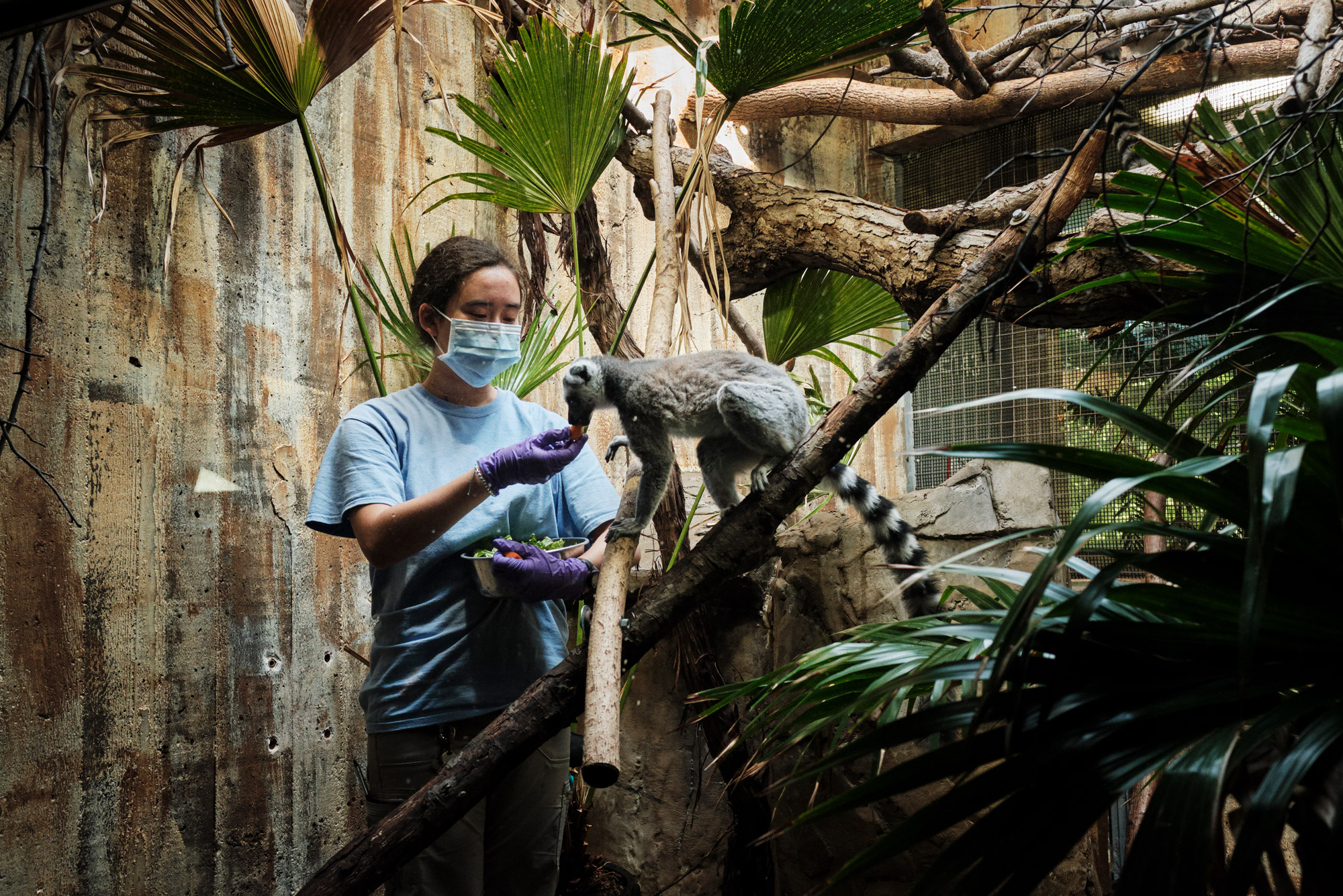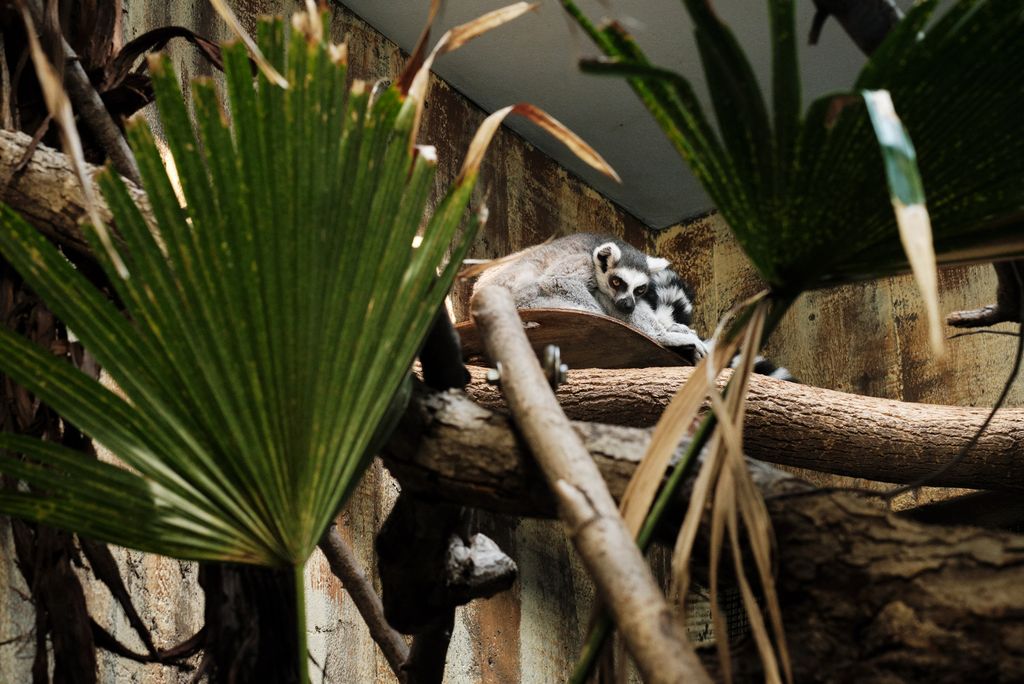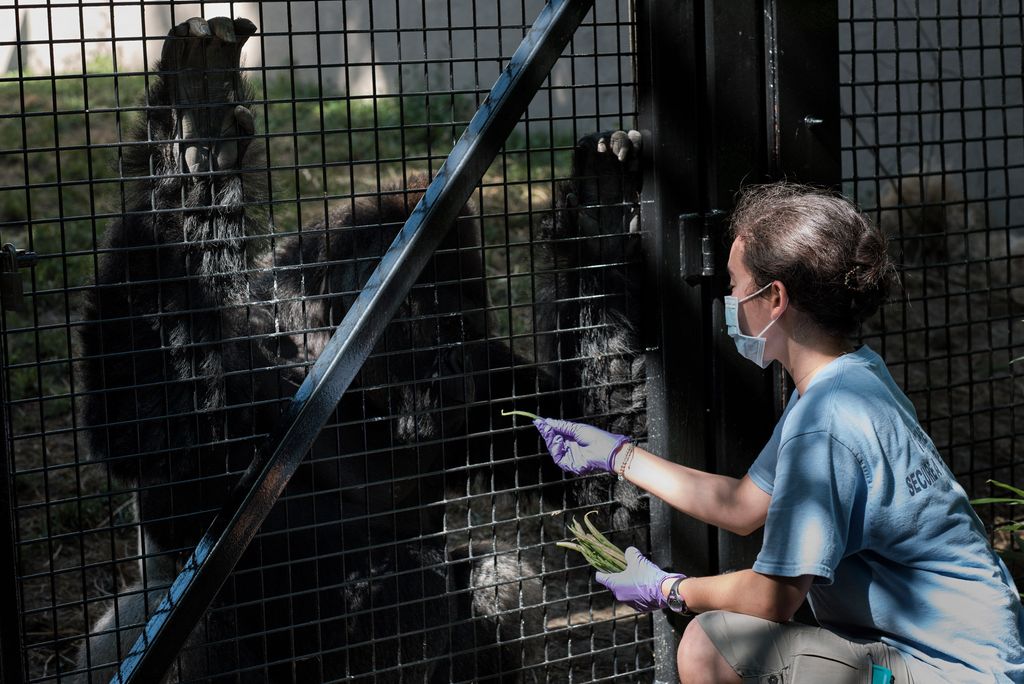My Summer as a Zookeeper at the Cleveland Metroparks Zoo

Every animal has a personalized diet, designed by a zoo nutritionist. Photos by Angelo Merendino
My Summer as a Zookeeper at the Cleveland Metroparks Zoo
Sargent student’s love of animals landed her a dream gig caring for cheetahs, gorillas, and other primates
Alenna Sze-Tu (Sargent’20) has been involved in zookeeping since she was 14, working weekends and summers in high school at the Binghamton Zoo at Ross Park in her hometown of Binghamton, N.Y. She later cared for Humboldt penguins at the Rosamond Gifford Zoo in Syracuse, N.Y., and sharks, rays, and jellyfish at the New England Aquarium.
This summer, Sze-Tu, who is working towards a bachelor of science degree in behavior and health, worked as a seasonal keeper in the Cleveland Metroparks Zoo’s Primates, Cats, and Aquatics building.
Job description:
This summer, I worked with an array of primates, including several species of old and new world primates, such as spider monkeys, gibbons, swamp monkeys, tamarins, nocturnal primates such as bushbabies and slow loris, and several species of lemurs, gorillas, and mandrills. I also cared for two cheetah brothers and a pair of fossa, the largest carnivorous mammal on Madagascar, related to a mongoose.
I absolutely loved it. I did routine husbandry, like cleaning exhibits, preparing diets, giving animals enrichment, administering medications and tracking overall health, and interacting with the public.
Overall grade for the job:
A.
How I landed the job:
I found it through the Association of Zoos and Aquariums website, which posts open jobs.
A typical day on the job:
My day started at 7 am, when I would get in and check all my animals. I walked the backs, the part of the exhibit where people don’t go. Then I walked the fronts, which is the public side. I made sure the animals hadn’t knocked anything down overnight. Then I would do medications: for instance, some of our older animals have arthritis, a few other animals have different conditions. Then I moved on to cleaning, feeding, and watering. We gave them enrichment—things for them to interact with that hopefully stimulate natural behaviors to keep them occupied and their minds and bodies working.
For example, the aye-aye [a long-fingered lemur] had a “treasure chest” toy, which is a metal box. With her tapping middle finger and rodent teeth, she can destroy almost anything—she puts holes in our walls. This box has six compartments, and each compartment we cover with a piece of wood and put a nut in it, and she has to tap each one to find which one has food in it. That keeps her occupied. It also uses her natural chewing behavior and her tapping finger skill.
Other animals eat rats, so we hide the rats around their exhibit so they have to search for them. Sometimes we put meat in puzzle feeders. Some animals get enrichment multiple times a day, especially the primates, because they are so smart. Some animals get popsicles, which are either made of seeds, fruits, and juice, or “bloodsicles,” which are a combination of blood and water, favored by cheetahs. It’s cool to watch them go after them.

The ring-tailed lemur has 13 alternating black-and-white bands on its tail.
Red-ruffed lemurs are vegetarians; they warn other group members about predators through a series of alarm calls.
Sze-Tu hosing off an exhibit.
Feeding a gorilla green beans through a strong gate.
In the wild, ring-tailed lemurs eat leaves, flowers, insects, and even small vertebrates.
At the end of the day, we re-medicate any animal that has twice-a-day medication. We shut down the building and walk backs and fronts again. Any animal who hangs outside during the day is brought inside for the night to keep them safer. We fill out keeper daily reports that say everything about our day, everything about the animals we saw. That’s our basic day, but you’re working with live animals so it varies a lot. The day can go just about anywhere.
Most common question I was asked:
“Where are the gorillas?” You can’t go into the exhibit with the gorillas since they are way stronger than the strongest man. Our male silverbacks are about 400 pounds, and females are about half that. The gorillas have an indoor and outdoor exhibit and their behind-the-scenes area, so that’s why I’d be asked where they were.
They’re highly intelligent. When we came in in the morning, they knew the routine. It’s not that they knew what you were saying, but we talked to them, told them when we were opening the door for instance, and I found that keeps them calm. It told them that everything was OK.
Career skills I acquired:
I learned multitasking, how to work on a team, and public speaking skills. You have to know how to medicate animals, handling, how to distinguish natural behaviors versus unnatural behaviors when an animal is sick or not feeling well. You have to know basic animal husbandry and the animals’ different needs and diets. It’s a lot of little things, getting an idea for each individual.
Most surprising or unexpected experience at one of the zoos I’ve worked at:

Working with penguins at my previous job in Syracuse at the Rosamond Gifford Zoo. I’m not a big bird person, but working with penguins is like working with mammals. I worked with a colony of 34 penguins, I was there for the breeding and rearing process. There are so many things you need to learn. They have their own territories, you get used to who is a little snappy, who is less likely to come up to you for food so that you have to seek them out to feed them. They are very interactive and fun to work with.
What I want to do after graduation:
Go into zookeeping. I’m still deciding what animals I want to work with; I especially like small-to-medium mammals, foxes, lemurs, red pandas. I like some of the smaller big cats, such as an ocelot.
As you progress in the field, you become a head keeper, a supervisor, you can work your way up to become an associate curator and a curator, who is in charge of all the zookeepers. That’s the end goal, but I want to stay for a while in zookeeping. I like being hands-on.
My advice for others seeking an internship or job in this field:
Experience, experience, experience. You need experience in this field in order to get a job. It’s a highly competitive field. It requires a bachelor’s degree in biology, zoology, or another animal-related field to get a full-time permanent position. People want to see that you are out there working, that you have the skills. A lot of people start in education or work as a volunteer. You’ll be moving around the country, so you have to be willing to go wherever you can get a job. You can’t specialize right away.
Comments & Discussion
Boston University moderates comments to facilitate an informed, substantive, civil conversation. Abusive, profane, self-promotional, misleading, incoherent or off-topic comments will be rejected. Moderators are staffed during regular business hours (EST) and can only accept comments written in English. Statistics or facts must include a citation or a link to the citation.